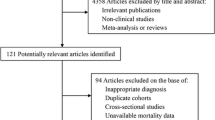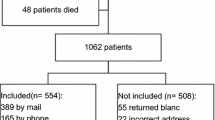Abstract
Purpose
Obstructive sleep apnea syndrome (OSAS) is common in adult population and it is associated with increased morbidity and mortality, especially due to cardiovascular disease (CVD). Both diagnosis, based on polysomnography, and treatment with continuous positive airway pressure (CPAP), carry a potentially high cost. The present study aims to analyze the cost-effectiveness of CPAP treatment versus no treatment, in the long-term, as it examines the effect of this treatment on the incidence of CVD.
Methods
A Markov model was constructed to observe the disease evolution in patients with OSAS based on published evidence. Data on treatment costs were collected from public hospitals in Greece. Within each cycle of the model, each patient may remain free of CVD, may develop CVD, may die due to a cause related to CVD, or may die from other causes. The model begins at the age of 55 years in a severe OSAS patient (apnea-hypopnea index ≥30/h) and lasts for 45 years.
Results
Within the limitation of the model, CPAP was found to be a cost-effective strategy versus no treatment, due to the reduction of the cost for the CVD treatment, when the analysis was restricted to the male population. Moreover, CPAP was found to be clinically more effective than no treatment, as it increases life expectancy in both males and females.
Conclusions
CPAP was found to be clinically more effective therapy than no treatment in relation to CVD and a cost-effective strategy in males with severe OSAS.
Similar content being viewed by others
References
Patil SP, Schneider H, Schwartz AR, Smith PL (2007) Adult obstructive sleep apnea: pathophysiology and diagnosis. Chest 132:325–337
Punjabi NM (2008) The epidemiology of adult obstructive sleep apnea. Proc Am Thorac Soc 15:136–143
Young T, Peppard PE, Gottlieb DJ (2002) Epidemiology of obstructive sleep apnea: a population health perspective. Am J Respir Crit Care Med 165:1217–1239
Trakada G, Chrousos G, Pejovic S, Vgontzas A (2007) Sleep apnea and its association with the stress system, inflammation, insulin resistance and visceral obesity. Sleep Med Clin 2:251–261
Marin JM, Carrizo SJ, Vicente E, Agusti AG (2005) Long-term cardiovascular outcomes in men with obstructive sleep apnoea-hypopnoea with or without treatment with continuous positive airway pressure: an observational study. Lancet 365:1046–1053
Peker Y, Hedner J, Norum J, Kraiczi H, Carlson J (2002) Increased incidence of cardiovascular disease in middle-aged men with obstructive sleep apnea-a 7-year follow-up. Am J Respir Crit Care Med 166:159–165
Wang X, Ouyang Y, Wang Z, Zhao G, Liu L, Bi Y (2013) Obstructive sleep apnea and risk of cardiovascular disease and all-cause mortality: a meta-analysis of prospective cohort studies. Int J Cardiol 169:207–214
Dong JY, Dong JY, Zhang YH, Qin LQ et al (2013) Obstructive sleep apnea and cardiovascular risk: meta-analysis of prospective cohort studies. Atherosclerosis 229:489–495
Mar J, Rueda JR, Durán-Cantolla J, Schechter C, Chilcott J (2003) The cost-effectiveness of nCPAP treatment in patients with moderate-to-severe obstructive sleep apnoea. Eur Respir J 21:515–522
National Research Council (2006) In: Colten HR, Altevogt BM (eds) Sleep Disorders and Sleep Deprivation: An Unmet Public Health Problem. The National Academies Press, Washington, DC
Chervin RD, Murman DL, Malow BA, Totten V (1999) Cost utility of three approaches to the diagnosis of sleep apnea: polysomnography, home testing and empirical therapy. Ann Intern Med 130:496–505
Pietzsch JB, Garner A, Cipriano LE, Linehan JH (2011) An integrated health-economic analysis of diagnostic and therapeutic strategies in the treatment of moderate-to-severe obstructive sleep apnea. Sleep 34:695–709
Tsara V, Amfilochiou A, Papagrigorakis MJ, Georgopoulos D, Liolios E, Alexopoulou C, Maniou C, Kithreotis P, Trakada G, Synodinos F, Vilos G, Steiropoulos P (2009) Guidelines for diagnosing and treating sleep related breathing disorders in adults and children (Part 2: treatment). Hippokratia 13:247–252
Fietze I, Penzel T, Alonderis A et al (2011) Management of obstructive sleep apnea in Europe. Sleep Med 12:190–197
Wilson PW, D’Agostino RB, Levy D, Belanger AM, Silbershatz H, Kannel WB (1998) Prediction of coronary heart disease using risk factor categories. Circulation 97:1837–1847
Allender S, Scarborough P, Peto V, Rayner M, Leal J, Luengo-Fernandez R, Gray A. (2008) European cardiovascular disease statistics. British Heart Foundation. http://www.bhf.org.uk/publications/view-publication.aspx?ps=1001443. Accessed 23 July 2014
Tountas G, Hellas Health I Study/Total Results. http://www.neaygeia.gr/pdf/HellasHealth_I_sunolika_apotelesmata.pdf (Article in Greek). Accessed 31 January 2014
Ayas NT, FitzGerald JM, Fleetham JA, White DP, Schulzer M, Ryan CF, Ghaeli R, Mercer GW, Cooper P, Tan MC, Marra CA (2006) Cost-effectiveness of continuous positive airway pressure therapy for moderate to severe obstructive sleep apnea/ hypopnea. Arch Intern Med 166:977–984
Chilcott J, Clayton E, Chada N, Hanning CD, Kinnear W, Waterhouse JC (2000) Nasal continuous positive airways pressure in the management of sleep apnoea. Trent Institute for Health Services Research, Leicester
Tousignant P, Cosio MG, Levy RD, Groome PA (1994) Quality adjusted life years added by treatment of obstructive sleep apnea. Sleep 17:52–60
The Continuous Positive Airway Pressure for the treatment of obstructive sleep apnoea-hypopnoea syndrome: a systematic review and economic analysis Produced by CRD/CHE Technology Assessment Group (Centre for Reviews and Dissemination/Centre for Health Economics), University of York. http://nice.org.uk/nicemedia/live/11724/33273/33273.pdf. Accessed 31 January 2014
Guest JF, Helter MT, Morga A, Stradling JR (2008) Cost-effectiveness of using continuous positive airway pressure in the treatment of severe obstructive sleep apnoea/hypopnoea syndrome in the UK. Thorax 63:860–865
National Institute for Health and Clinical Excellence (2008) www.nice.org.uk/TA139. Accessed 31 January 2014
WHO: European Health for all Database: Available at http://www.euro.who.int/en/data-and-evidence/databases/european-health-for-all-database-hfa-db Accessed 31 January 2014
Escourrou P, Luriau S, Rehel M, Nédelcoux H, Lanoë JL (2000) Needs and costs of sleep monitoring. Stud Health Technol Inform 78:69–85
Bixler EO, Vgontzas AN, Lin HM, Ten Have T, Rein J, Vela-Bueno A, Kales A (2001) Prevalence of sleep-disordered breathing in women: effects of gender. Am J Respir Crit Care Med 163:608–613
Bixler EO, Vgontzas AN, Ten Have T, Tyson K, Kales A (1998) Effects of age on sleep apnea in men: I. Prevalence and severity. Am J Respir Crit Care Med 157:144–148
Canto JG, Goldberg RJ, Hand MM, Bonow RO, Sopko G, Pepine CJ, Long T (2007) Symptom presentation of women with acute coronary syndromes: myth vs. reality. Arch Intern Med 167:2405–2413
Heimonas E et al (1997) Panhellenic study of acute myocardial infarction. Hellenic J Cardiol 38:123–137, Article in Greek
Filippidis FT, Schoretsaniti S, Dimitrakaki C, Vardavas CI, Behrakis P, Connolly GN, Tountas Y (2014) Trends in cardiovascular risk factors in Greece before and during the financial crisis: the impact of social disparities. Eur J Public Health. Mar 10. [Epub ahead of print] PMID:24614651
Conflict of interest
The authors declare that they have no conflict of interest.
Author information
Authors and Affiliations
Corresponding author
Rights and permissions
About this article
Cite this article
Trakada, G., Economou, NT., Nena, E. et al. A health-economic analysis of diagnosis and treatment of obstructive sleep apnea with continuous positive airway pressure in relation to cardiovascular disease. The Greek experience.. Sleep Breath 19, 467–472 (2015). https://doi.org/10.1007/s11325-014-1050-5
Received:
Revised:
Accepted:
Published:
Issue Date:
DOI: https://doi.org/10.1007/s11325-014-1050-5




